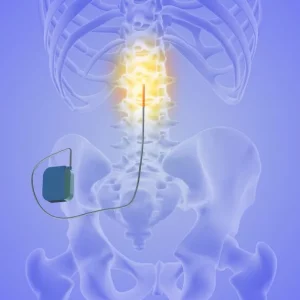Because respiratory complications are the leading cause of death in individuals with spinal cord injuries, it’s essential to understand what causes them and how to manage them.
To help you prepare, this article will discuss how a spinal cord injury can affect respiratory functions, the most common respiratory complications that occur after SCI, and effective management interventions.
How Spinal Cord Injuries Increase the Risk of Respiratory Complications

A high-level spinal cord injury can disrupt control over an important respiratory muscle called the diaphragm.
Specifically, the C3, C4, and C5 spinal nerves innervate the diaphragm. After a spinal cord injury at or above the C5 level, messages from the brain may not be able to get past the damage, resulting in loss of control over the diaphragm.
This causes breathing to be weakened, therefore it’s essential to seek immediate medical attention. With the help of a ventilator, respiratory functions may be restored.
Generally, the higher one’s level of injury, the greater their risk of experiencing respiratory complications. While respiratory complications are most common after cervical spinal cord injuries, they can also occur (to a less severe extent) after thoracic injuries. The thoracic nerves mostly control the muscles in your trunk. Without motor control over the intercostal (the muscles in-between in the ribs) and abdominal muscles, individuals may experience decreased lung volume and weak coughing.
Additionally, individuals with spinal cord injuries are more likely to experience respiratory complications within the first year after injury because this is when respiratory functions are weakest. Fortunately, during the first year, spontaneous improvements in respiratory functions often occur.
Now that you understand how spinal cord injuries can affect respiratory functions, let’s discuss some of the most common respiratory complications among individuals with SCIs.
Spinal Cord Injury Respiratory Complications
Various respiratory complications can arise following a spinal cord injury due to loss of control of the diaphragm, low lung volume, and weak coughing.
Below, we’ll discuss 5 common respiratory complications that can occur after SCI:
1. Respiratory Failure
Breathing facilitates the exchange of oxygen into the body and CO2 out of the body. Respiratory failure occurs when your blood doesn’t have enough oxygen and/or too much CO2.
Without enough oxygen or with too much CO2, the body cannot properly function. This can result in difficulties breathing, a blue tint around the face, disorientation, and if left untreated, will result in death.
2. Pneumonia
Pneumonia is the leading cause of death in individuals with spinal cord injuries.
It’s caused by a respiratory infection that inflames the tissues in the lungs, causing secretions to fill the air sacs. Individuals with spinal cord injuries often do not have a strong enough cough to get rid of the buildup, which causes secretions to accumulate.
Those with pneumonia may experience shortness of breath, pale skin, fever, and excessive congestion.
Individuals generally respond well to antibiotics, but alternative treatments include suctioning, quad coughing, and air-pressurizing technologies.
3. Pulmonary Embolism
Another common respiratory complication that can occur after a spinal cord injury is pulmonary embolism. Pulmonary embolism occurs when a blood clot blocks the arteries in the lungs, making it difficult to breathe.
The heart pumps blood to the lungs, where it is oxygenated and returned to the heart to get pumped throughout the rest of the body. During pulmonary embolism, blood flow is restricted and cannot get oxygenated. This results in low blood-oxygen levels, which ultimately causes the body to dysfunction.
Treatment for pulmonary embolism typically consists of using blood thinners, and in some cases, surgery.
4. Sleep Apnea
Sleep apnea is a condition characterized by unstable breathing during sleep. As a result, individuals may wake up multiple times throughout the night and fail to get a full night’s rest. Those with sleep apnea usually experience snoring and sleepiness during the day.
The respiratory system works harder while you’re sleeping; however, with a spinal cord injury, muscle weakness and low lung volume can contribute to additional respiratory distress.
Treatment for sleep apnea usually involves the use of a continuous positive airway pressure device (CPAP) that supplies pressurized air into your airways while you sleep.
5. Atelectasis
Atelectasis describes the complete or partial collapse of the lungs due to blocked airways. This is primarily attributed to low lung volume following spinal cord injury.
Additionally, atelectasis is often asymptomatic until it affects a larger area of the lungs. When this happens, individuals may experience dyspnea (shortness of breath), coughing, and chest pain.
In the following section, we’ll discuss tips for managing respiratory complications after spinal cord injury.
Tips for Managing Spinal Cord Injury Respiratory Complications
Because respiratory complications can affect each individual differently, it’s essential to seek personalized care. Depending on the severity of one’s respiratory complications, different management interventions will be necessary.
Some of the most effective interventions to manage respiratory complications after SCI include:
- Working with a Speech-Language Pathologist: Individuals with weakened respiratory functions after an SCI should work with a speech therapist for diaphragmatic strengthening, improving breath support, and learning to manage secretions.
- Practicing Breathing and Coughing Exercises: Practicing breathing exercises can help gradually expand lung volume. Likewise, practicing coughing exercises can help clear your lungs and prevent fluid build-up.
- Maintaining a Healthy Diet and Managing Your Weight: Individuals who are overweight are more likely to experience respiratory complications. Maintaining a healthy weight can help lower your risk.
- Quit Smoking: Smoking has been shown to negatively affect lung function in individuals with spinal cord injuries, as it does with the general population. It also increases the chances of respiratory infections that can cause pneumonia.
- Drinking Lots of Water: Drinking water helps thin the consistency of secretions, which makes them easier to cough out.
- Exercising Regularly: Exercise can help you develop endurance and better control your breathing, but be sure to consult with a doctor to make sure it’s safe for your specific condition.
Because individuals with spinal cord injuries are more susceptible to respiratory complications, it’s essential to be proactive and take preventive measures. If you notice signs of respiratory complications, seek early medical attention to prevent them from progressing.
Respiratory Complications After Spinal Cord Injury: Key Points
A spinal cord injury can affect control over the muscles necessary for breathing. As a result, individuals may experience low lung volume and a weakened cough, which increases their risk of developing respiratory complications.
We hope this article helped you become more aware of potential respiratory complications that can arise after a spinal cord injury and how to manage them.










